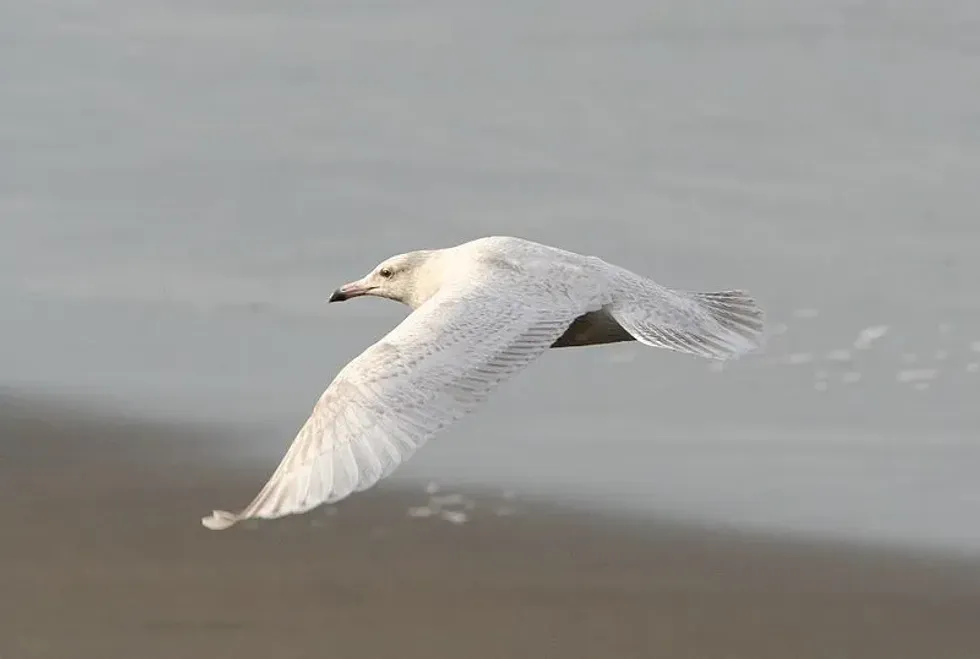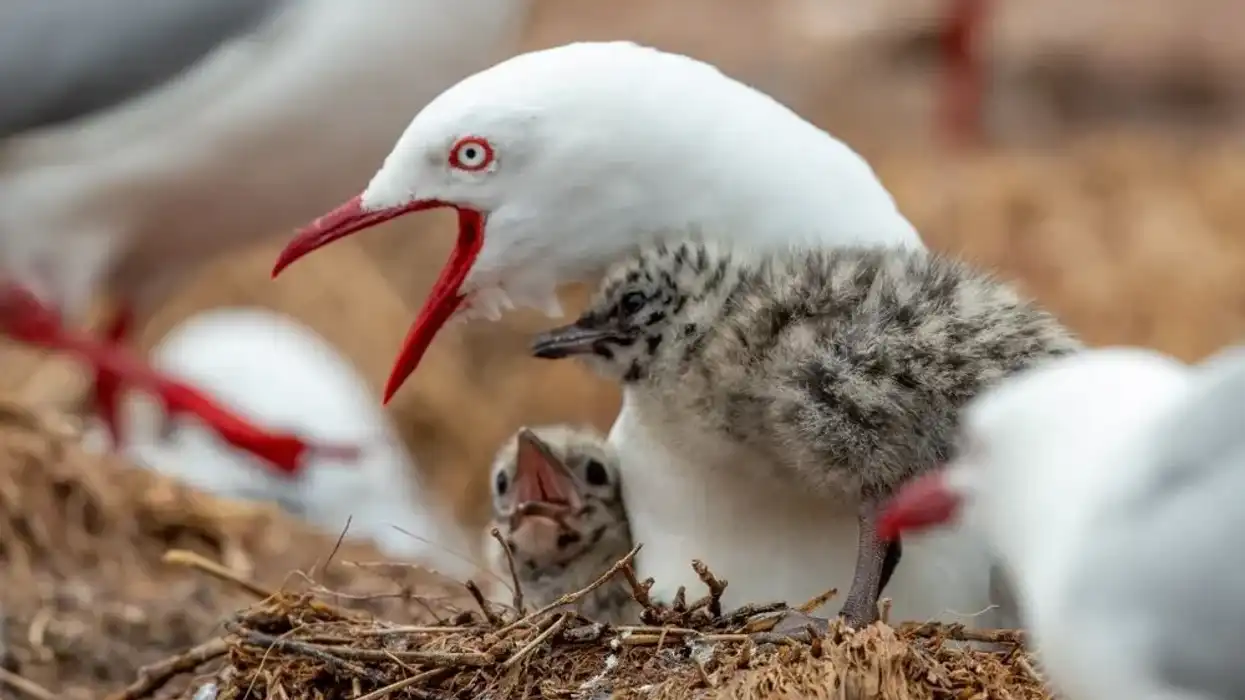Known as the second-largest gull in the world next to the great black-backed gull, the glaucous gull is both a predator and a scavenger that typically nests on seaside cliffs and shorelines, often near colonies of other common species of birds. They are omnivores and opportunists and can be quite aggressive when hunting for prey.
This is mostly because of their large size. Glaucous gulls fly over foxes as a distraction, allowing them to swiftly grab prey.
Glaucous gulls are not divers and prefer to snatch their prey from below the surface. Adults are also known to attack other birds who attempt to steal their food.
The glaucous gull is the only large gull species commonly seen in high Arctic regions. During the winter, glaucous gulls are seen around large inland lakes and they have reached parts of the US such as Washington, Hawaii, and Alaska.
If you liked reading these fun facts about the glaucous gull, you may also want to check out articles about the sea eagle and the laughing gull too.
Glaucous Gull Interesting Facts
What type of animal is a glaucous gull?
As mentioned, they are the second largest gull in the world and are the only known large gull species to inhabit the high Arctic. A gull is a wild bird known to have webbed feet, long wings, and white plumage.
What class of animal does a glaucous gull belong to?
The glaucous gull is under the Aves class of birds. In total, there are 54 species of gulls in the world, and out of all of them, the glaucous gull is the second biggest in size.
How many glaucous gulls are there in the world?
This species of seabird has an extremely large range, and its population trend is stable.
Some recent population estimates of this bird from different parts of the world include an estimate of 85,000 pairs in Alaska, between 6500–10,000 pairs in European Russia, and between 30,000–100,000 pairs in Greenland.
Where does a glaucous gull live?
They live by the ocean in polar regions also known as the Arctic, this includes the coasts of the Arctic Ocean and neighboring seas, parts of Alaska, Hawaii, Finland, northern Canada, Iceland, Greenland, Sweden, Russia and Norway. In winters, this bird migrates from the north to places in the far south.
There have been sightings of the bird in North America, particularly in Washington and Florida. It has also been seen in Mexico and in parts of both North America and South America.
What is a glaucous gull's habitat?
Glaucous gulls are common inhabitants of coastal bays, shorelines, landfills, and large inland lakes during winter. They typically nest in cliff ledges, islands, and beaches and forage in garbage dumps, fish-processing plants, harbors, mudflats, sewage lagoons, flooded fields, and fish spawning areas
Who do glaucous gulls live with?
Most adults live with their pairs and colonies, gathering in flocks. They are quite sociable with other birds and species who they do not consider prey like wintering birds and other gulls. However, conflict over food is constant when foraging.
How long does a glaucous gull live?
The oldest recorded glaucous gull (Larus hyperboreus) lived for at least 22 years, but their average lifespan in the wild is 15 years. The species in the North American hemisphere are said to live longer.
How do they reproduce?
It takes four years for their chicks to mature sexually. Adults are usually monogamous and reunite with their pair for nesting once a year for several years at a time.
Like all birds, an adult glaucous gull lines the nest and lay eggs in the nest. Both adults incubate the eggs and feed the chicks once they hatch to form a family. Unmated males form colonies and forage together on the coast.
What is their conservation status?
The glaucous gull's conservation status is Least Concern. This indicates that they are currently not at risk of extinction and there are very few concerns about their conservation
Glaucous Gull Fun Facts
What do glaucous gulls look like?
They typically have a white head, belly, and wing tips, a white-gray back, and a yellow bill with a red spot.
How cute are they?
Glaucous gulls are quite cute as chicks but begin to look more regal as adults because of their large size.
How do they communicate?
They signal each other through sounds and calls, with a distinct glaucous gull cry for mating rituals, predator warnings, and to communicate the location of food sources.
How big is a glaucous gull?
Adult glaucous gulls are 26.7-28 in (68-71 cm) long. They are larger than a herring gull and slightly smaller than a great black-backed gull.
How fast can a glaucous gull fly?
They can fly as fast as 40 mph (65 kph).
How much does a glaucous gull weigh?
They typically weigh 2.2-6.6 lb (1-3 kg).
What are their male and female names of the species?
There isn't a difference in glaucous gull identification for males and females. They are simply all called glaucous gulls (Larus hyperboreus).
What would you call a baby glaucous gull?
Juvenile glaucous gull babies are all referred to as chicks.
What do they eat?
They are omnivores whose diet is quite versatile. They eat fish, insects, mollusks, starfish scraps, eggs, smaller birds or mammals, carrion, and some plants like seeds, berries, and grains as part of their diet.
Are they dangerous?
They are not particularly a threat to humans, but as adult birds, they are opportunistic predators that have various aggressive foraging strategies depending on their habitat and prey.
Would they make a good pet?
They are considered wild birds, therefore they are usually protected by state and federal law. It is illegal to keep wild birds as pets or to sell them or their parts, such as their feathers.
Aside from the fact that a bird this size would require a lot of space, they are also natural predators and scavengers, so it is not advisable nor safe for them to live among smaller mammals in a domesticated setting.
Did you know...
The term 'glaucous' is derived from the Latin word 'glaucus' which means 'blue-gray' or 'green'.
The glaucous gull also has four subspecies: Leucretes (found in its Northern Canada, Iceland, and Greenland range); Pallidissimus (found in its North Siberia to the Bering Sea range); Barrovianus (found in its north of Canada to Alaska range); and Hyperboreus (found in its north-west Europe to Siberia range).
In winters more young glaucous gulls travel from the Arctic to the far south than adults.
An average glaucous gull wingspan is 60 in (152 cm) wide.
Are gulls smart?
This specific type of bird in general is very clever. They are fast learners who can easily remember and even pass on behaviors and calls made by other species. They have a complex understanding of these behaviors for communication purposes and can mimic a wide range of vocals and body movements.
Is the glaucous gull the same as the glaucous-winged gull?
The glaucous gull should not be confused with the glaucous-winged gull as they have some slight differences. A glaucous gull bird will have only white wing tips at any stage of development, while a glaucous-winged gull's wing tips change from pale brown to gray as they mature. Their similar features include a yellow bill and pink legs and feet.
Here at Kidadl, we have carefully created lots of interesting family-friendly animal facts for everyone to discover! Learn more about some other birds including the crowned eagle, or the tawny eagle.
You can even occupy yourself at home by drawing one on our flying seagull coloring pages.










